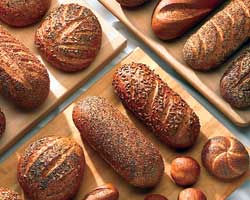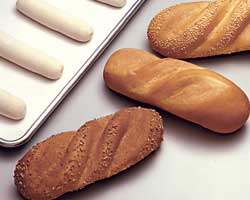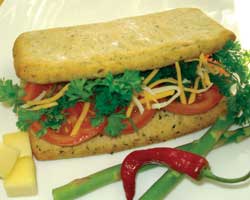
It’s hard to believe that a mere five years ago, menu developers, purchasing agents, food manufacturers and restaurant customers were in the grip of the low-carb craze.

Today, breads and sandwiches are on everyone’s “must-have” list and eateries specializing in these products are growing rapidly. “Other than beverages and doughnuts, sandwiches are the fastest-growing segment in quickservice,” says David Henkes of Technomic in Chicago. His company tracked the growth of sandwich concepts and bakery cafes in its Top 500 Chain Restaurant Report.
- In the sandwich category, 61,224 units were operating in 2006, a 4.3 percent increase over 2005.
- Sandwich sales are growing twice as fast as units are opening. Consumer spending totaled $20 billion in 2006, an 8.6 percent jump over 2005.
- Sandwich chains with notable growth include Jimmy Johns, McAlister’s Deli, Potbelly Sandwich Works, Jason’s Deli and Firehouse Subs.
- Bakery cafes represent a $3.6 billion segment. In 2006, they numbered 2,652 units—up 5.6 percent. But sales rose 13.3 percent from the year before.

Artisan Breads From Rich Products
Inside the bread basket
As both breads and sandwiches have gained status and renewed popularity, there’s been an accompanying uptick in quality and variety. “Restaurants can no longer get away with serving lousy bread,” says Nancy Silverton, founder of La Brea bakery, an artisan bread supplier. “Customers expect better quality and a greater assortment on the menu.”
At first, restaurants were baking breads in-house to feed patrons’ expectations, but some have abandoned that practice because it isn’t cost- or labor-efficient, Silverton claims. Purchasing bread from wholesale bakery operations is another way to go. But that means relying on daily deliveries and possible waste from stale goods. While value-added products have long been available, manufacturers are stepping up with improvements. Frozen doughs, par-baked breads and thaw-and-serve fully baked products now boast artisanal touches, distinctive flavor profiles and healthier components.
What to buy
So what’s the best bread format to buy for your operation? It depends on your volume, storage space and menu. Competing sandwich concepts try to differentiate themselves with their bread, often contracting with bakeries or suppliers for custom products that they finish baking in-house. But “a lot of QSRs don’t have ovens,” says Gary Duszynski, director of foodservice bakery marketing for Rich Products in Buffalo, New York. “Fully finished breads and rolls are generally better for that segment.
Duszynski outlines the main types of sandwich-ready bread and roll products.

Frozen Bread Baked Up
Par-baked refers to products that are 85 percent baked. The manufacturer bakes the bread or rolls just until they’re golden-brown, then immediately freezes them for delivery. “An operator can figure out how much they’ll need in a time period, take that amount out of the freezer and bake up sandwich rolls in 3 to 5 minutes, says Tim Konacek, director of quality and R&D at Signature Breads in Chelsea, Massachusetts. This evolving category offers great flexibility and consistency for fast-casual sandwich concepts. Plus, companies like Rich’s and Signature are constantly experimenting with new shapes, whole grains, ethnic varieties and seasonings to update and upgrade products.
Proof and bake dough comes in a variety of sizes and shapes; it’s thawed in the cooler overnight, then proofed in a warm location for 45 to 60 minutes before baking. Mistakes can happen during proofing, so this format requires attention and skilled labor. “As operators demand more convenience, the days of proof and bake are declining,” Duszynski says.
Fully finished breads and rolls are fully baked, ready to use. These can be sourced either fresh from a wholesale bakery or frozen from a manufacturer. The category includes pullman bread (used in paninis), ciabatta and sub and Kaiser rolls.
Trends to watch
Now that artisan breads are practically mainstream and wraps and paninis are standard fare, what’s next on the sandwich board?
Whole grains. Bread producers are incorporating whole wheat flour, rye, millet, flax seed, oats and other hearty grains to boost fiber and nutrition. Signature Breads’ multigrain mini-baguette and whole-grain ciabatta are both seeing a lot of activity. “The challenge is not to make the bread too dense,” says Signature’s Tim Konacek. “Our supplier came up with a dough conditioner to lighten it up.” Rich’s uses Conagra white whole wheat flour—a blend that balances white bread texture with whole wheat flavor and health—to formulate some of its products.
Punched-up flavors. Cheeses, seasonings and ingredients like roasted garlic and sundried tomatoes are adding intrigue to ciabatta, focaccia and other sandwich carriers. Atlanta’s Rising Roll is currently testing a chipotle cheddar bread. But be cautious about overdoing the flavors—a handful of varieties is smarter than a dozen because you want the flexibility to mix and match breads and fillings, says Rich’s Duszynski. As “extras” he suggests marble rye, roasted garlic and toasted sunflower. “You can always sprinkle seeds or toppings on a dough or par-baked product to change the flavor profile.”

The Shape of Things to Come: Signature's Piegga Bread
Cool shapes. Signature Breads’ unique piegga (meaning “pleat” or “wallet” in Italian) really took off when it was launched last year. It’s a garlic-flavored focaccia-style bread that folds over the sandwich filling “soft-taco style,” Konacek explains. “We hope to expand the line with a whole grain version.”
Gluten-free. About one in 125 consumers have celiac disease and are looking for breads made with gluten-free flour. Rich’s just introduced a 41⁄4-ounce round gluten-free sandwich carrier in January, baked and packaged in an entirely separate facility where no wheat flour products are made. Signature Breads is developing an ethnic-style wheat-free bread using a different starch. These products take more R&D to create a good flavor and texture.
Wheat prices go sky high
In the last half of 2007, the price of wheat rose sharply to land just shy of $10 per bushel. This compares with a price of $4.75 a year ago and the long-term average of $3.60, reports Bill Lapp, president of Advanced Economic Solutions in Omaha, Nebraska. The rise reflects an extremely tight global supply. Domestic wheat stocks fell to their lowest level in 60 years, claims the U.S.D.A., and world production fell short due to poor weather conditions in Europe and Australia.
“The wheat market is driving up the price of our base item—the roll,” says Jeff Perkins of Amato’s sandwich chain in Portland, Maine. “Even owning our own bakery doesn’t help much.” He’s not alone—every sandwich concept is feeling the pinch, trying to absorb costs in the short term. Operators say they will eventually have to raise menu prices. The fillings are going up as fast as the bread, with chicken and dairy leading the charge.
But wheat prices could slide back down in 2008, Lapp predicts. “If weather cooperates, world wheat production is projected to bounce back due to expanded acreage and yields,” he notes. “If that happens, prices should recede toward $5 to $7 per bushel.”
Product cutting
Par-baked multigrain mini baguette
Led by Tim Konacek, Director of Quality and R&D, Signature Breads
Chelsea, Massachusetts
- Open the case. All the breads should be consistent in size and shape. Consistency is very important for a sandwich roll.
- Examine the product in its frozen state. Par-baked breads should look a little wrinkly and pale in color.
- Bake off the roll. Use the equipment normal to your operation—either a convection or regular oven. Bake according to timing on package, but take some product out a little sooner and some a little later. Certain customers prefer a lighter, softer crust, others want a darker, crispy exterior. Stick with the timing that works best for your operation.
- Judge the appearance of the bread. The crust should crisp up and lightly brown. Split the roll horizontally, leaving it attached on one side. The crumb should look moist and you should see speckles of grain inside; the hinge of the roll should hold together to make a sturdy sandwich.
- Taste the bread. The flavor should be fresh with toasted wheat and slight nutty notes from the grain. Notice a little sweetness from the addition of honey and molasses.
Q & A with Nancy Silverton
Founder, LaBrea Bakery and co-owner Osteria Mozza, Los Angeles
How have foodservice bread needs changed since you started LaBrea Bakery in 1989?
The artisanal bread movement upgraded bread service. Par-baked breads and rolls make it possible for operators to source premium products—down to the small mom-and-pop restaurant. The ciabatta roll is the top seller in the line now. Lately, requests for whole-grain breads have surged.
How did the low-carb phase affect your product mix?
Artisan bread sales didn’t drop off, but customers who were limiting bread gravitated toward whole-grain products. We started doing more by adding whole wheat, millet, triticale and other grains to the dough. In the end, it had a positive effect—consumers are now eating more whole grains.
What must an operator source to run a successful sandwich program?
Purchasing high-quality bread is number one. You also want to have a good variety. Some customers prefer crusty French bread, others want softer rolls; some ask for whole-grain, others order white. It’s important to have a range of fillings as well—a mix of approachable choices like egg salad with more creative options, such as prosciutto and fresh mozzarella. And I like to offer a few spreads, like tapenade, pesto and flavored mayonnaise.
Any tips for dealing with the high price of sandwich ingredients?
Customers still equate bread as a cheap food source, but you have to pass on part of the increase. And be conscious of waste—cross utilize leftovers from another meal service. Grilled flank steak or braised short ribs make delicious sandwiches
.
Members help make our journalism possible. Become a Restaurant Business member today and unlock exclusive benefits, including unlimited access to all of our content. Sign up here.